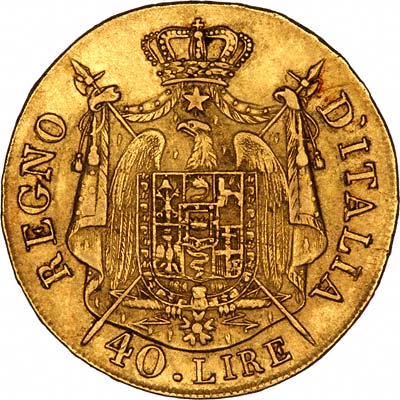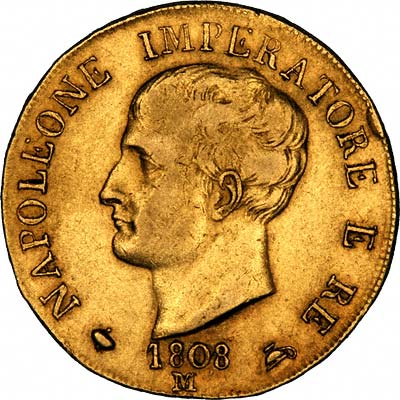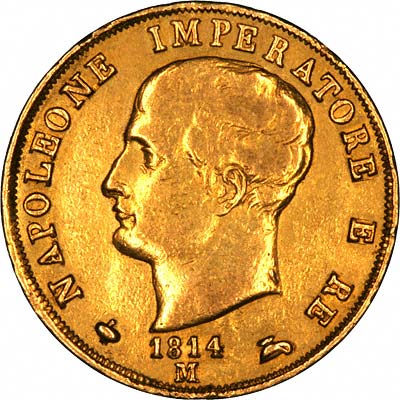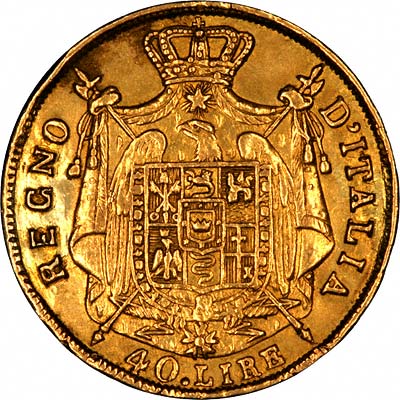
Brief History
Before the unification of Italy about 1861, Italy consisted of many small states, kingdoms, and duchies. This makes the period more interesting for historians and coin collectors alike.
Sardinia was under the rule of the House of Savoy from 1720, and eventually became the core of the unified Italian state.
Italian States Gold Coins Because of its long history, and many small states, many different types and designs of Italian gold coins have been issued. Among the most famous is the ducat, also called a zecchino and issued in numerous states. In other states, its equivalent was the scudo (scudo d'oro) or florin. Double sized coins were doppia, the italian for double, and there were also strangely enough half doppie, quarter doppie and eighth doppie. Sovranos and half sovranos were issued by Lombardy - Venetia, ongaros in Mantua and Milan, doppiettas (little doubles) by Sardinia, oncia by Sicily, ungheros and ruspone in Tuscany. Lire were introduced as early as 1758 in Genoa, and were eventually also issued by a number of other states including Sardinia. Lira was the name chosen for the new coinage of the kingdom starting in 1861. The most readily available of the modern Italian gold coins are the 20 Lire of Victor Emanuel II and Umberto I.
List of Italian States
Bardi
Belgiojoso
Belmonte
Bozzolo
Cagliari
Campi
Casale
Castiglione Del Gatti
Castiglione Delle Stiviere
Cispadine Republic
Cisterna
Correggio
Cuneo
Desana
Emilia
Gazzoldo
Genoa
Ligurian Republic (Liguria)
Guastalla
Italian Republic
Kingdom of Italy
Kingdom of Naples
Kingdom of Napoleon
Liguria
Livorno
Loano
Lombardy - Venetia
Lucca
Maccagno
Mantua
Massa Di Lunigiano
Messerano
Milano (Milan)
Modena
Monaco*
Naples & Sicily (Two Sicilies)
Papal States
Papal States Zecchini
Parma
Piacenza
Piedmont Republic
Piombino
Pisa
Porcia
Retegno
Ronco
San Giorgio
San Marino*
Sardinia
Savoy
Sicilia (Sicily)
Solferino
Soragna
Subalpine Republic
Tassarolo
Trento
Tresana
Tuscany
Two Sicilies (Naples & Sicily)
Urbino
Vasto
Vatican*
Venezia (Venice)
Venice Zecchini
Ventimiglia
Vercelli
* Monaco is an independent state, but we have listed it here because of its close association with Italy.
* San Marino is an independent state, but we have listed it here because of its close association with Italy.
* The Vatican is an independent state, but we have listed it here because of its close association with Italy.

Reverse of 1808 Italian Kingdom Of Napoleon 20 lire Gold Coin
 Obverse of 1808 Kingdom Of Napoleon 40 lire Gold Coin
Obverse of 1808 Kingdom Of Napoleon 40 lire Gold Coin
 Obverse of 1814 Kingdom of Napoleon 40 Lire Gold Coin
Obverse of 1814 Kingdom of Napoleon 40 Lire Gold Coin
 Reverse Of 1814 Kingdom of Napoleon 40 Lire Gold Coin
Reverse Of 1814 Kingdom of Napoleon 40 Lire Gold Coin
32 - 36 Harrowside, Blackpool, Lancashire, FY4 1RJ, England. Telephone (44) - (0) 1253 - 343081; Fax 408058;
E-mail: Contact Us The URL for our main page is: taxfreegold.co.uk
